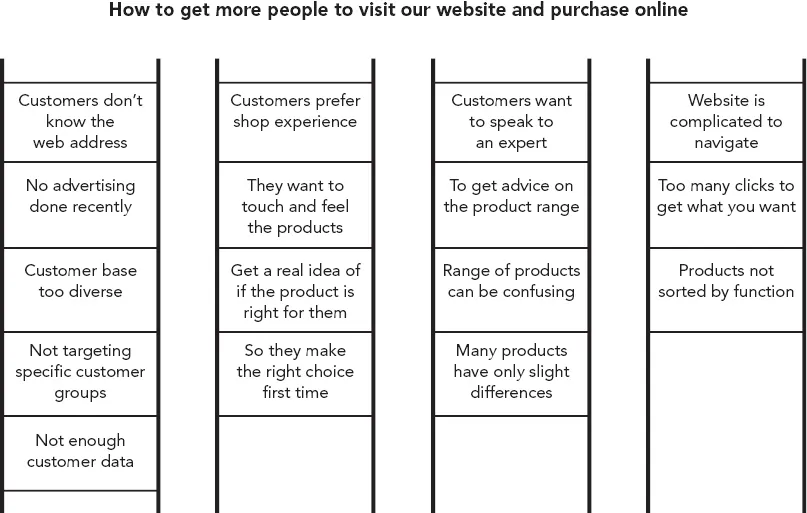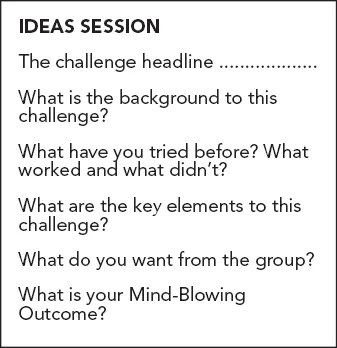1. The Creative Process
In order to think creatively, it’s important to first understand how ideas are formed. The romantic version of the creative process often involves a lone, tortured artist trapped in painful penance in an unfurnished hut as he pours his angst onto canvas, or an eccentric inventor with unruly hair tinkering in his shed trying to perfect his time machine. Luckily, the creative process that many creative theorists talk about, and that which forms the bedrock of the idea generation system that I use, is considerably easier to adopt. There are four key stages:
- Preparation
- Incubation
- Illumination
- Evaluation.
This model of creativity was first posited by the social psychologist Graham Wallas in 1926 and has formed the basis of many theories of creativity since. Whether you are an individual or an organization engaged in creating new ideas, it is important to understand these steps so that you can give time to the process and have a system in place that reflects these key stages of creativity to encourage ideas. If you keep these four key stages in mind when you begin the work of generating ideas, whether individually or in a group, you will work with the natural process that the brain undertakes when being creative.
People who are well versed in generating ideas – in being creative – often go through these stages quite subconsciously. The brain is like a muscle: asking it to do something new can feel, strange, unnatural and forced, but with practice it gets easier. However, while the process may sound like a cumbersome and long-winded way to get to a new idea, these four stages represent something that can happen in your brain in a matter of seconds. For example, say you are walking to the shops to buy dinner, as you have a friend joining you tonight whom you haven’t seen for a while. ‘What shall I get for dinner?’ you muse. You walk some more, whistling as you go, and you spot a kid with a cowboy hat on. ‘Oh, we could have steak … or beef wellington …’ you think (once your brain has gone from cowboys to steak, probably via a cattle ranch). You then see a poster advertising a circus. ‘What about pudding … custard? Maybe with apple pie?’ (Your brain immediately pictured a circus clown, with a custard pie hurtling toward his face). You are nearly at the shops when you hear someone speaking Italian, and suddenly think: ‘Ah, maybe we could have pasta instead?’ As you pull a trolley toward you, you weigh up the options and decide that steak is a little pricey, and beef wellington will involve too much preparation when you could be catching up with your friend. So pasta it is.
And there you have it – the creative process in action:
- Preparation – wondering what to get for dinner
- Incubation – walking and letting inspiration affect your thinking
- Illumination – the ideas
- Evaluation – weighing up all the options.
This thinking process happens hundreds of times a day without you even knowing about it, and so if you consider yourself ‘not an ideas person’ you probably need to think again.

Let’s look at the four stages of the creative process in a little more detail. As you use these stages to structure your own creative process, it may well feel a bit awkward and cumbersome to begin with. However, like practising a tennis swing or playing the piano, the more you practise, the more easily you will do it. Eventually, the stages of creativity will simply be part of your everyday thought process, and you won’t need to go through them consciously (although it can still be a useful exercise to do so).
Preparation
Preparation is essential to achieving a creative output, but can sometimes be overlooked in the rush to get to the ‘ideas bit’. This is a critical mistake. It is all very well deciding to make a cake, getting out the bowl and spoon and adding ingredients as they occur to you, but if you haven’t put the preparation in there is every chance that you will get some way down the line only to discover that you’ve got no flour, you ate the last of the jam for breakfast and you haven’t got a cake tin.
So taking time to analyse the challenge that you are facing will pay dividends further down the line. This analysis creates a much deeper understanding of the challenge, which will help create richer and more original ideas.
It is also critical that during the preparation stage that you start to uncover any underlying assumptions that are latent in your understanding of the brief, which could stifle your creativity. For example, your business challenge might be to get more sales with your three-person sales force, but your staff cannot possibly fit more prospective client visits into their working day. The obvious solution to the problem is to either employ more sales people or make them work overtime. But what is the assumption here? One of them is that to create a sale, the sales person needs to visit the prospect. Remove this assumption and you can immediately see many other solutions – such as for all the prospects to come to you for a sales seminar, or for your sales people to offer Skype meetings to demonstrate that you really value your clients’ time.

In this ‘preparation’ stage, there is a useful tool I often employ to help people really get under the skin of the problem and ensure that all contributing factors are uncovered: Ladder Analysis.
Ladder Analysis
This tool works equally well if you are working individually or in a group – but if the latter, make sure you work on a scale large enough to suit the group, with either a flip chart or large whiteboard.
1. Across the top of your page, write your challenge as you see it. For example: ‘How to get a lot more people to visit our website and purchase online.’
2. Under this challenge, draw a ladder with just a top rung:

3. On this top rung, write down a key reason why you think you are not getting enough website visitors. For example, this could be because people do not know the website address.
4. Consider this reason, and ask yourself: why? Now draw in a second rung and jot down on this rung the reason why – such as the fact that you have not advertised the website address.
5. Keep asking ‘why?’ to the reasons that you write on each rung, extending your ladder downwards until you run out of answers.
6. Now go back to the challenge statement at the top of the page, and draw a new ladder beneath it. Consider another element that is part of the problem: in this instance, it could be that people prefer buying your product in a shop.
7. Work your way down the ladder in the same way as before, identifying all the reasons that contribute to the top statement, that people prefer to buy in a shop.
8. Create as many analysis ladders of varying lengths (depending on the depth of the analysis) as you feel you need to really explore the challenge in full. So your page might end up looking something like this:

At the end of the exercise, you will have a much better understanding of all the different elements that contribute to your challenge, the root cause of some of the issues and the reason why some assumptions have been made. Now you can go on to write a much more informed brief.
The brief
Look around your business. What challenges do you currently face? To show the range of issues for which you can generate ideas with this creative process, I have recently worked with businesses to tackle the following challenges:
- How to launch a new product
- How to get internal departments to work more effectively together
- How to knock the customers’ socks off with amazing service
- How to bring the company vision and values to life for everyone in the business
- How to streamline key processes to save time and money
- How to work with a local charity in new and exciting ways.
When you are tackling a business challenge and trying to generate creative ideas, ensure you take time to assemble all the facts into a concise, informative brief. Once you have done the ladder analysis, use the insights it provided alongside other information you have in order to give a full, rounded picture of the challenge and the background to it. A great brief – one that brings the problem to life and gives insight into customers and the reason why it is being tackled – will help brains focus on the right elements of the challenge. It will provide enough information that it allows the group to concentrate on generating ideas rather than trying to deal with unanswered questions, yet gives the group permission to be as creative as they can possibly be.
Use this Challenge Checklist template to help you. Each point is explained in further detail below:

The challenge headline
This headline must sum up the challenge that you are facing. I always find it useful to use ‘How to …’ as your starting point, as it helps you focus on the issue without making it seem impossible. Make the headline short, inspiring and precise and aim for no more than twenty words – many more will make it difficult to concentrate on the exact problem in hand. Don’t be tempted to include several parts of the same challenge, or more than one challenge. The best challenge headlines are extremely single-minded; this helps keep the ideas on track as well as encouraging you to keep delving deeper for rich, creative solutions.

Or this: How to create an online resource for teenagers about healthy living, as well as ideas for offline promotions that advertise the site and ideas for prizes for an online competition.
This headline is almost a paragraph long. There are at least three different challenges stated; using this would result in the ideas being too scattered and vague.
Instead, crea...
